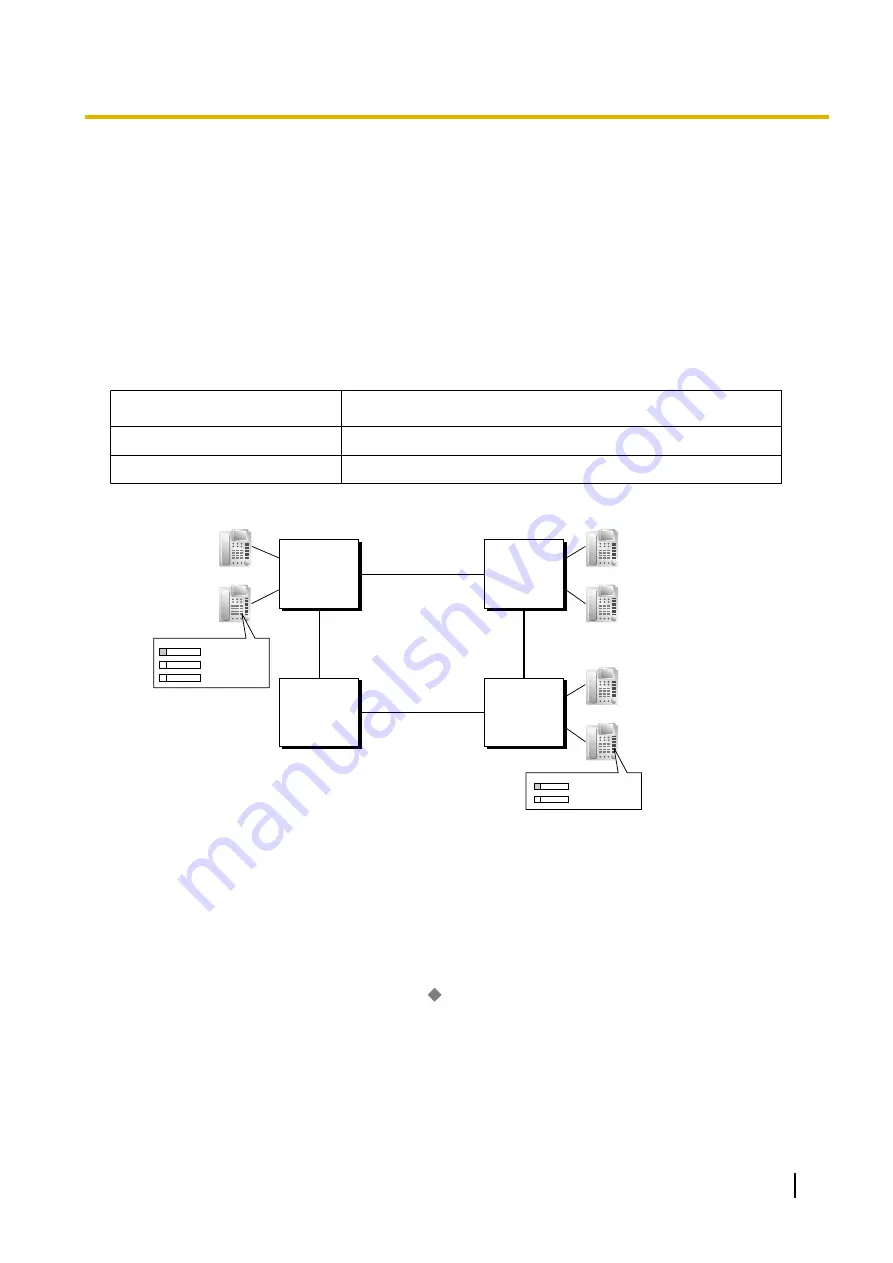
1.30.5 QSIG Enhanced Features
1.30.5.1 Network Direct Station Selection (NDSS)
Description
When PBXs are networked using ISDN or IP-GW cards, it is possible to assign flexible buttons as Network
Direct Station Selection (NDSS) buttons. These buttons are used to monitor the status of extensions connected
to up to seven other PBXs in the network, and to make or transfer calls to those extensions with one touch,
like normal DSS buttons. This allows operator functions to be centralised even when there are offices in remote
locations.
NDSS buttons show the status of the monitored extension as follows:
Light pattern
Status
Off
The monitored extension is idle.
Red on
The monitored extension is busy or has set DND for trunk calls.
[Example Network]
PBX-1
Network
ID 1
PBX-2
Network
ID 2
2001 (busy)
2002 (idle)
4001 (idle)
PBX-3
Network
ID 0
PBX-4
Network
ID 3
Extn. 2001
Extn. 2002
Extn. 4001
1001 (busy)
Extn. 1001
Extn. 2002
Monitor extension
Monitor
extension
[Programming Procedure]
1.
Routing Table Assignment
TIE Line Routing and Modification tables must have been programmed in advance for all PBXs in the
network, to allow calls to be made and transferred between PBXs (
®
In the programming example that follows, the PBXs in the network use the Extension Number method, as
shown in the illustration above. However, the PBX Access Code method can also be used.
2.
Network PBX ID Assignment
Assign a Network PBX ID to each PBX in the network.
®
11.2 [9-2] Network Data Transmission—
Network Data Transmission for Centralised Operator
•
IDs 1-8: Can monitor extensions at other PBXs, and transmit monitor data about local extensions. Each
ID number can be assigned to one PBX within the network.
•
ID 0: Retransmits monitor data throughout the network. This ID number can be assigned to multiple
PBXs.
3.
QSIG Port Setting [Monitored PBX]
Feature Guide
363
1.30.5 QSIG Enhanced Features
Summary of Contents for HYBRID IP-PBX KX-TDA200
Page 15: ...Section 1 Call Handling Features Feature Guide 15...
Page 91: ...User Manual References 1 2 1 Basic Calling Feature Guide 91 1 5 4 Trunk Call Features...
Page 113: ...User Manual References 1 2 2 Easy Dialling Feature Guide 113 1 6 1 Memory Dialling Features...
Page 156: ...3 1 2 Settings on the Programming Mode 156 Feature Guide 1 11 4 Headset Operation...
Page 175: ...User Manual References 1 4 2 Holding a Call Feature Guide 175 1 13 1 Call Hold...
Page 385: ...Section 2 System Configuration and Administration Fea tures Feature Guide 385...
Page 430: ...430 Feature Guide 2 4 3 Local Alarm Information...
Page 431: ...Section 3 Appendix Feature Guide 431...
Page 456: ...456 Feature Guide 3 4 13 KX TDA30 PSMPR Software File Version 5 0xxx...
Page 457: ...Index Feature Guide 457...
Page 463: ...Feature Guide 463 Notes...

































